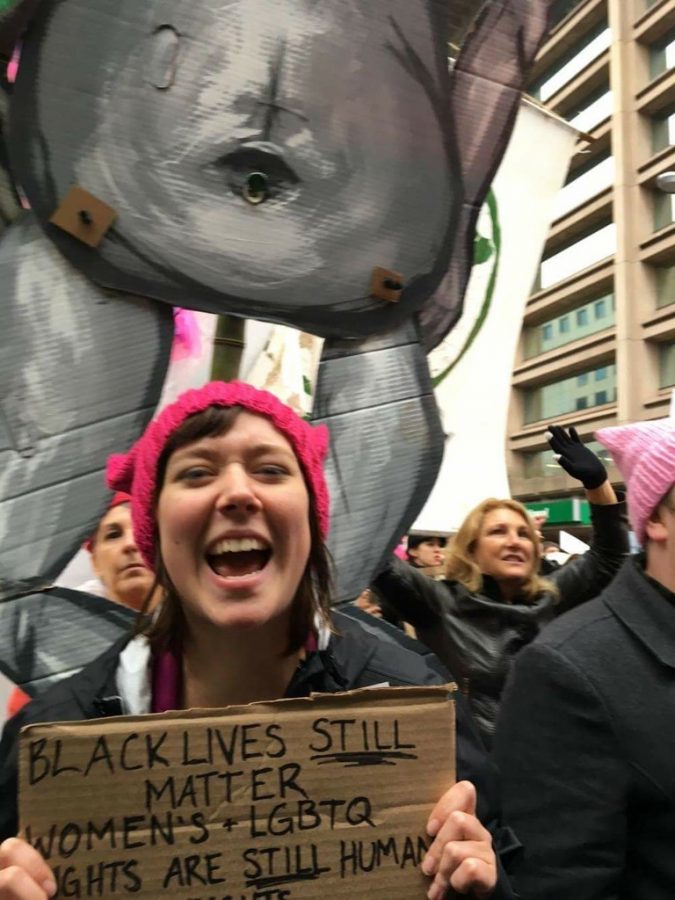Your donation will support the student journalists of Northern Kentucky University. Your contribution will allow us to purchase equipment and cover our annual website hosting costs.
NKU community reflects on Women’s March, women’s issues
February 13, 2017
Mackenzie Boyd went to the march at Washington D.C. She said that she got her motivation to be politically active from her mother.
Since the inauguration of President Trump, some women have lent their voices to movements speaking out about rights that they believe have been threatened and the issues they are worried about in the years ahead.
These worries were expressed through various means, one being the international Women’s March. Below, three women in the NKU community reflect on their own participation and what it meant for them.
______________
Boyd: “We were all friends at that moment.”
By: Nicole Browning, Assistant Arts and Life Editor
Mackenzie Boyd said her mom is her main inspiration behind her efforts to become more politically involved.
Her mother has supported Clinton since the 2008 election but was not previously involved in her campaign prior to the 2016 election.
Her mother would have her out canvassing for Clinton’s campaign and give Boyd bags of buttons to hand out to her friends.
“She’d keep us updated and she’d talk about the different debates,” Boyd said. “She’d text me to see if I was watching the debates and when I’d come home we’d watch Clinton’s speech.”
When Clinton came to Cincinnati on the campaign trail to speak, Boyd and her mother went together.
“On election night, she was the one I went to when I was crying my eyes out,” Boyd said.

The environment was both welcoming and exciting as many celebrities spoke at the march.
In the aftermath of the election, Boyd searched for an outlet to express her feelings. She found this outlet in the Women’s March in Washington D.C. on Jan. 21. On all seven continents, millions gathered to express similar sentiments and to object regulations and policies that they felt were an infringement on their rights. Boyd, a junior and integrative studies major, described the event as a spiritual experience.
Boyd went with two friends, an NKU alumni and a student. They stayed at her friend’s house in Arlington, Virginia, the night before the march.
They arrived early to a crowd that was large, but didn’t fill 14 blocks yet, Boyd said.
She said that they were surrounded by people who were there for the same reason, which contributed to a warm and friendly environment.
Boyd also witnessed celebrities come out to join the march.
“We didn’t actually get to see the stage, but we were right next to backstage, so we were like ten feet away from Gloria Steinem and Emma Watson and all the famous people that attended,” Boyd said. “We didn’t realize how big it had gotten.”
They understood the size and scope of the crowd when one of them went to the restroom. Boyd said if anyone separated from the group, they wouldn’t see each other for the rest of the day.
“We also realized that when we got to a higher elevation, we couldn’t see the end of the crowd,” Boyd said. “That was this insane feeling. I felt like my heart was going to explode with just how great this all felt.”
Despite the massive size of the crowd, Boyd ran into people from NKU who also attended the march.
Boyd reunited with a group called Bread and Puppet. The group held a large mast and circular sign which read, “We are all in the same boat.” She could see the group from a mile away.
It was at this moment that Boyd said she had started crying.
“Everybody had their crying moment, while they were there,” Boyd said, “At least everybody we had talked to, and everybody in our group.”
Boyd said the two main issues addressed at the march were the need to support Planned Parenthood and voter apathy.
“If you look at the statistics on Planned Parenthood, it is majority minority women who use it and who are going to be affected,” Boyd said.
The march reminded people that the movement doesn’t end with one march, Boyd said. She expressed that those involved couldn’t give up the cause.
“We cannot finish marching, go home, pat ourselves on the back and then turn off the news and stick our heads in the sand,” Boyd said. “We have to get involved.”
She said that young people need to get involved politically, including running for office and contacting local representatives to express their concerns.
Boyd was impressed with how so many groups of people were represented on Capitol Hill.
“Minorities, both sexes, all genders,” Boyd said. “Everybody was very accepted. There was even somebody who was walking around in a vest that said ‘Bikers for Trump.’ And nobody was giving him a hard time.
“We were all friends at that moment.”
______________
Mader Meersman: “I choose love.”
By: Mackenzie Manley, Managing Editor
The first of the presidential debates aired. Julie Mader-Meersman watched it with her husband and young children.
At one point in the debate between Donald Trump and Hillary Clinton, Alicia Machado was brought into the conversation, a former Miss Universe who Trump referred to as “Miss Piggy” in a series of tweets penned by Trump.
The next morning, Mader-Meersman, a visual communication professor, sifted through several news outlets, listening to an array of interviews. She was struck. The body shaming perspective was doubled down on, rather than forgiven.
In response, she ran down the hall and made the prototype of her first solidarity sash, which she later shared with colleagues.
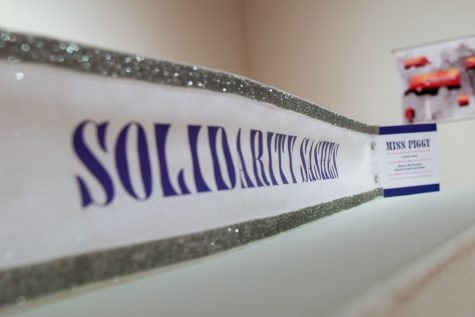
Julie Mader-Meersman created the solidarity sashes to shed light on the hurtful language that was surrounding the election.
“You can be Miss Universe and still be body shamed. Her sash might as well have been Miss Piggy,” Mader-Meersman said. “I just felt so much empathy for any woman who struggles with body image; thousands, if not millions, do. I wanted to stand up for that person and those people.”
Her sashes were on display in the School of the Arts, lined on a wall with one another. Each sash on the bottom row contained a different derogatory comment targeted toward women said by Donald Trump. Above the insults, sashes with “I choose love” hung.
When she first made the sashes, she was coincidentally teaching her students about typography and the different forms that it takes.
Going into class, she said that she told her students about the project. She told them that they would see her around wearing the sashes, but would not bring them into the classroom. As a professor, she wanted to keep her own political bias from leaking into the classroom.
“What struck me is that, my students started asking questions about the project and one of them said, ‘I want to be the first person to wear that sash,’” Mader-Meersman said.
As time progressed, the project began to evolve.
She formed the sashes into book holders. When on, sash across the chest, a small book hangs at the wearer’s hip. Contained in the book are gender specific insults.
According to Mader-Meersman, it was here that people started wanting to get involved.
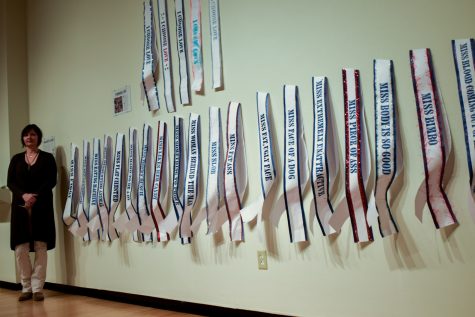
Mader-Meersman wore them in her daily life. She wore them to the grocery store, to the gas station and in her own home. One by one, she said, people began to show interest in wearing them as well as making the solidarity sashes.
Mader-Meersman said she saw no reason why anyone couldn’t use her idea to make a statement alongside her own.
Despite the interest, Mader-Meersman hoped that she could put the project behind her and move on after the election. When she learned of Trump’s victory, she was shocked.
“I only could think to myself that this would be behind me after election day, and I wanted it to be behind me,” Mader-Meersman said. “I thought, ‘You know what, what am I going to do? How am I going to conduct myself?’”
She decided to choose love. Love not only for those who aligned to her own political beliefs but for those who didn’t, Mader-Meersman said.
Seven days after the election, Mader-Meersman and around 12 others gathered — a group consisting of families, friends, men, women and children — to create their own sashes with the message “I choose love” at the Newport World Peace Bell.
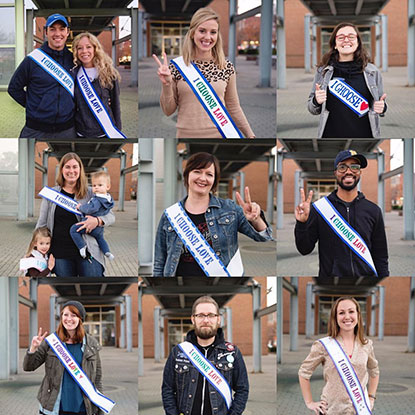
After the election results, Mader-Meersman gathered with a small group in solidarity.
“All the rights that women fight for so hard are bashed down in the process, historically,” Mader-Meersman said. “So here I am, I’m willing to put myself in history to stand against prejudice.”
Mader-Meersman and others later wore these sashes at the Women’s March at Washington Park in Cincinnati. Coming together, she said, felt empowering and good.
After the election, she reflected, many people are struggling to look up again. The Women’s March was larger than she expected and she said that the environment was warm and inviting.
“I’m getting chills just thinking about it. The experience was way more powerful and moving than I expected,” Mader-Meersman said. “I knew it would feel better to come together because I had already had this other version, though it was only 12 people, and I was able to come to grips with a lot of things just by doing so.”
What was most striking about the march was the juxtaposition of the event feeling both peaceful and loud at the same time. Walking alongside bounds of people, Mader-Meersman said the signs did the screaming.
Mader-Meersman said a lot of the pain and the turnout was a result of so many civil rights coming off the site at the White House. Many felt like they went for the jugular on their societal values.
Going forward, Mader-Meersman said that engaging congressional representative and continuing to articulate one’s point of view is how the discourse can continue.
“I don’t know the answer except to choose love for myself,” Mader-Meersman said.
______________
Creamer: “Listening is the first step to potential change.”
By: Christopher Decker, Sports Editor
Keely Creamer first heard of the Women’s March when her friends announced they’d be going to the demonstration being held at Washington Park in Cincinnati.
Her answer?
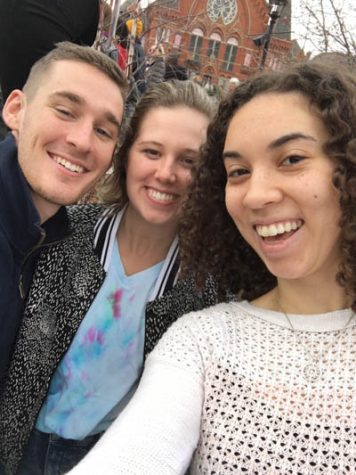
Keely Creamer was invited to attend the Women’s March by her friends
“Absolutely.”
Along with the thousands of people who participated at the local Women’s March and millions more across the globe, the NKU volleyball player rode with her friends to Washington Square on Jan. 21 to lend her voice to the movement.
“I liked what it stood for,” Creamer said. “I think a lot of people wanted to make their voices heard about a lot of issues that are real issues and I think they accomplished that and that’s really admirable. I want to be a part of something great like that.”
Though she didn’t realize the scope of the event until she arrived, Creamer was amazed to see the crowd that showed up.
The crowd only grew after Creamer and her friends arrived, so much so that many people were unable to hear the speakers who showed up to express their views.
“We got just close enough we could hear everything,” Creamer said. “It got to the point where there were so many people that people way in the back couldn’t hear. Which is disappointing but also cool because more people showed up than they expected or else they would have had a better sound system.”
Creamer enjoyed the posters that people created for the march and appreciated some of the humor in the messages.
“A lot of them were humor based. It kept things on the lighter side,” Creamer said. “There were real issues there but you can do it and still have fun with it. [One pictured someone] holding a torch and there were a bunch of different hands and a bunch of different colors. The unity symbolism from that was really cool.”
The march not only allowed women’s rights activists to express their views, but members of the Black Lives Matter movement and LGBTQ community also were able to make their voices heard.
“I have a lot of diversity in my friend group,” Creamer said. “I had a friend who went to stand for his LGBTQ rights. I had a friend who went for the Black Lives Matter portion. I had a couple friends advocating for general women’s rights. It was such a nice atmosphere. Everyone there was really supportive and peacefully wanting to make their voices heard.”
These different movements intersecting, and the support that flowed through the members of the crowd, created a sense of camaraderie between marchers, according to Creamer.
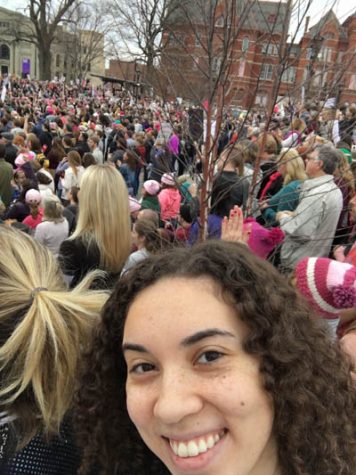
Keely Creamer snapped a selfie with the crowd in Washington Square
“We liked the fact that everyone there, even though there were different things that were being stood for, kind of had everyone’s back as a whole,” Creamer said. “It was like a giant support system circling all these different issues.”
One of the biggest surprises of the day was the lack of resistance Creamer and the rest of the marchers saw on their route. This wasn’t the case in Columbus, Ohio, however, where the march Creamer’s mother participated in was met with hostility.
“I was surprised there weren’t more people trying to start fights. I didn’t see any of that,” Creamer said.
Creamer believes the march was a success and was an important step on the way to causing change.
“I liked the fact that when people gather in mass to voice their opinion, people will listen,” Creamer said. “I think that’s all that needed to be accomplished. We get enough people and at least voice our opinions, we don’t even have to be aggressive about it. Say what you need to say and in a big enough number the higher ups will listen.
“I think listening is the first step to potential change.”

